Sailing as a hobby resurfaced in my life rather recently. Sailing 14-30’ boats while on vacation rekindled my love for the sport, gained during summers aboard my family’s cruising sloop on Lake Champlain. The challenge for a Tucsonan, of course, is how to make this a practical
endeavor. Apart from the lack of water, this is a great place to sail- wind and sun nearly every day. The challenge would be finding a craft suitable for the small city lakes, what many would call ponds or water hazards based on their size.
 The boat that would serve best would need to be easily cartopped. It would need to be stable and spacious so that passengers would feel comfortable and safe. It needed to be simple for ease of setup and for friends’ sailing lessons. It also needed to be slow and shallow of draft. Finally, it needed to be economical to obtain and maintain.
The boat that would serve best would need to be easily cartopped. It would need to be stable and spacious so that passengers would feel comfortable and safe. It needed to be simple for ease of setup and for friends’ sailing lessons. It also needed to be slow and shallow of draft. Finally, it needed to be economical to obtain and maintain.
It turns out that no one has such a boat in production. There are fast ones, pretty ones, light ones, plastic ones, all of which someone is enjoying thoroughly, but none that appealed to me. Having grown up sailing, I knew where my preferences and the manufacturers’ compromises ran afoul. I began to consider building.
There are a great many designs available, and via the web, I looked at hundreds. My best friend, Christopher surprised me with the study plans catalog from
www.instantboats.com . In a few days, the array had been winnowed to one all-around best design: Phil Bolger’s 8’ Rubens Nymph.
Most “Duckworks” readers are familiar with tack & tape construction. I had some FRP experience, and just a little woodworking experience; both horizons were broadened by this project. It was a real challenge for me. The only power tools that I used were a drill and a sander, using hand tools for everything else in the name of simplicity and for some healthy fatigue.
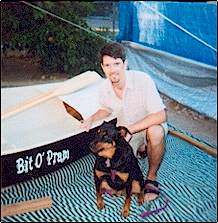 Nine months and $1500 later, “Bit O’ Pram,” named for the pram-style hull and for a Monty Python joke, sails 5 days a week, meeting or exceeding every expectation.
She was christened in dry dock in the back yard with a bottle of Mogollon Apache Trout Stout (brewed in Arizona) as my family, wife Maggie and First Mate
Rubydog, looked on. Their patience and companionship allowed this project to succeed. In fact, when Christopher walked into our living room to see dusty plywood strips atop 3 1/2’ horses said of my
then-fiancee Maggie, “Wow – she really loves you, Man.” Nine months and $1500 later, “Bit O’ Pram,” named for the pram-style hull and for a Monty Python joke, sails 5 days a week, meeting or exceeding every expectation.
She was christened in dry dock in the back yard with a bottle of Mogollon Apache Trout Stout (brewed in Arizona) as my family, wife Maggie and First Mate
Rubydog, looked on. Their patience and companionship allowed this project to succeed. In fact, when Christopher walked into our living room to see dusty plywood strips atop 3 1/2’ horses said of my
then-fiancee Maggie, “Wow – she really loves you, Man.”
Some details and photos follow, but first, I have a few words about my process. Everyone who knows how I toiled and saved to do this asks, “Was it worth it?” It becomes more worth it every day as I enjoy sailing, and as the memories of the fumes, dust, injuries and frustration fade. I had no idea where this project would take me physically, intellectually, and emotionally. If there had been any clue, I may not have proceeded. But with her christening and launch, I feel parts of me that weren’t there before. I hadn’t known of my potential to create something this beautiful, this functional, this liberating. Together, “Bit O’ Pram” and I sail the little waters of the personal frontier.
Hull:
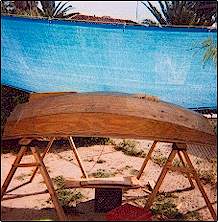 The hull design is the Bolger/Payson Rubens Nymph. Panels are 1/4” ply, bulkheads and transoms are 3/8”. Transoms are reinforced with stringers in the bow, and an oversized “motor plate” (she will NEVER wear an eggbeater!) in the stern. All seams are double-taped and faired with FRP putty. All areas of the hull are covered in 1-3 layers of 10 oz. cloth, plus external bias tapes joining the bulkhead regions. Really what I have here is a wood-cored fiberglass boat.
The hull design is the Bolger/Payson Rubens Nymph. Panels are 1/4” ply, bulkheads and transoms are 3/8”. Transoms are reinforced with stringers in the bow, and an oversized “motor plate” (she will NEVER wear an eggbeater!) in the stern. All seams are double-taped and faired with FRP putty. All areas of the hull are covered in 1-3 layers of 10 oz. cloth, plus external bias tapes joining the bulkhead regions. Really what I have here is a wood-cored fiberglass boat.
Decks of 5/8” Ply were added to add torsional rigidity and provide space for storage and flotation. $24 worth of foam pool toys provides (calculated) neutral buoyancy (retail ethafoam would have cost $120). She is heavily ballasted with 4-30lb. sandbags to stick to the cruising boat axiom of 1:3 ballast ratio, and keeping enough of her in the water for stability and control. The bags are moved for balance or removed for passengers to keep sailing weight approx 400 - 450lbs.
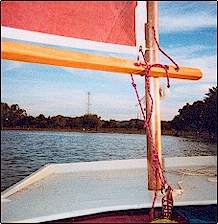 There is a moderately sized skeg aft, and two keelsons forward. A leeboard to port was shortened, widened, hinged, and given a bulbous foil for upwind performance. The contact plate is made from UHMW polyethylene, formerly known as Maggie’s cutting board. Rudder size was drastically reduced and shaped by eye, resulting in a balanced, light helm, appropriate to such a heavy boat. Under sail, she feels like the Cal 20 I borrowed last year.
There is a moderately sized skeg aft, and two keelsons forward. A leeboard to port was shortened, widened, hinged, and given a bulbous foil for upwind performance. The contact plate is made from UHMW polyethylene, formerly known as Maggie’s cutting board. Rudder size was drastically reduced and shaped by eye, resulting in a balanced, light helm, appropriate to such a heavy boat. Under sail, she feels like the Cal 20 I borrowed last year.
Rig:
This rig is simple. Apart from the sail, anything can be replaced from True Value, and everything is fastened with knots: bowline, square, fishermans, overhand, and figure eight. It is a sliding gunter rig built of copper pipe, fir yard and boom, and nylon line. It is compact, about 10 feet, yet allows a tall rig, about 17 feet. This is important since many of our man made lakes are in depressions or canyons. I am particularly proud of the serpentine gallows/downhaul/vang that reduces twist, even under a deep reef.
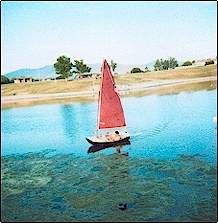 The sail is from the very helpful Lee and Jennifer at www.sailoutlet.com
. It is a Rolly Tasker tanbark, crosscut 3-batten sail with about a 2:1 aspect ratio. Sail area can be altered between 44-22 sq ft. via 4 reef points on the yard. The foot of the sail is rolled around the boom- the traditional reefing method. Sail area is reduced in high winds to avoid overload and keep heel in the optimum 5-15 degree range. We haven’t dunked yet – she’s not that kind of boat. An 8’ pram should be physically unable to point 45 degrees, yet she does.
The sail is from the very helpful Lee and Jennifer at www.sailoutlet.com
. It is a Rolly Tasker tanbark, crosscut 3-batten sail with about a 2:1 aspect ratio. Sail area can be altered between 44-22 sq ft. via 4 reef points on the yard. The foot of the sail is rolled around the boom- the traditional reefing method. Sail area is reduced in high winds to avoid overload and keep heel in the optimum 5-15 degree range. We haven’t dunked yet – she’s not that kind of boat. An 8’ pram should be physically unable to point 45 degrees, yet she does.
Appointments:
The foam raft material also makes great seats. I promised everyone a “floating lawn chair,” and was able to deliver. Painted areas around the seats are impregnated with grit. There is a rowers seat amidships. While sailing, I usually sit to port to adjust the leeboard, balancing the boat with ballast bags or passengers. It has been a refreshing change from the typical small-boat gymnastics that can terrify newcomers. Storage under the decks is dry and easily accessible. A portable cooler fits near the helmsman’s seat.
On Land:
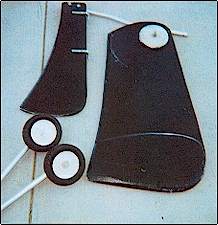 On land, she sits in a three-point stance on the keelsons and skeg. Landing gear made from telescopic crutch-ends and lawnmower wheels aids launch and retrieval ($17 vs. the $120 production equivalent.) They are removed –near shore- after launch.
On land, she sits in a three-point stance on the keelsons and skeg. Landing gear made from telescopic crutch-ends and lawnmower wheels aids launch and retrieval ($17 vs. the $120 production equivalent.) They are removed –near shore- after launch.
The changes that I made added 20+ lbs. To the hull, so she’s a handful to load on to my pickup
single-handed. I built skids of PVC pipe which fit the rack’s crossbars, enabling me to lurch her 100+ lbs. into place. Many people said, “Get a trailer,” or “buy rollers,” or “can’t you use pulleys?” “Nonsense,” said I, adding plates to each bar of my weight set. Problem solved. |
![]()